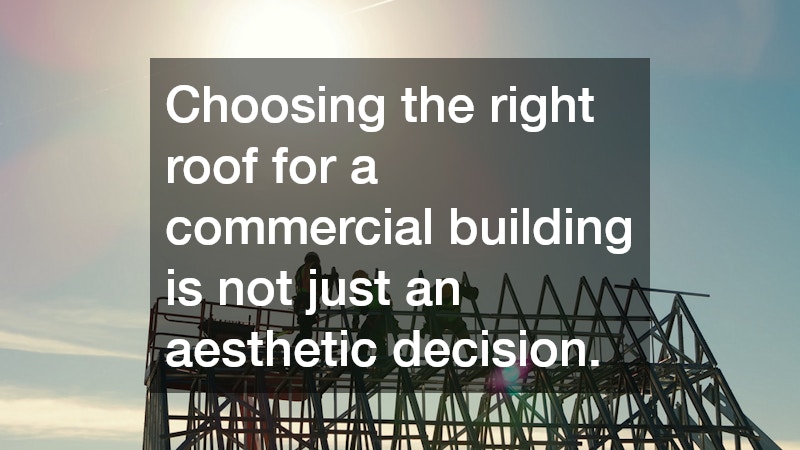Choosing the right roof for a commercial building is not just an aesthetic decision. It involves understanding different types of roofing materials, insulation options, and long-term cost implications. In this article, we will explore the most common commercial roof types that every business owner should become familiar with.
Built-Up Roofing (BUR)
Built-up roofing, commonly known as BUR, has been around for over a century. It consists of multiple layers of bitumen alternated with reinforcing fabrics, creating a finished membrane.
This type of roof is known for its durability and is often used on low slope roofs. The layers, typically made of tar and gravel, make it an excellent choice for waterproofing. When installed correctly by commercial roofing professionals, BUR systems can last anywhere from 15 to 30 years.
The initial cost of a BUR system can be substantial, but its longevity and low maintenance make it a cost-effective option in the long run. Maintenance typically involves eliminating water pooling and keeping drainage systems clear. Because of its composition, BUR provides excellent insulation, which can significantly reduce heating and cooling costs. Additionally, its gravel top layer adds an extra level of fire resistance and UV protection. As a result, it’s particularly favored in regions with harsh, sunny climates.
BUR systems do have some drawbacks, primarily related to their weight. Installing a BUR roof requires a structurally sound building that can support its heavy mass. Potential complications during installation include the risks associated with heating bitumen on-site. Therefore, hiring experienced commercial roofing professionals is crucial for a successful BUR installation. Despite these challenges, BUR remains a go-to option for many businesses due to its proven performance and reliability.
Modified Bitumen Roofing
Modified bitumen roofing is an evolution of the built-up roof, designed to address some of its limitations. It blends hot asphalt with rubber and plastic polymers to form a tough layer of protection. This roofing type offers excellent tensile strength, making it less prone to cracking under fluctuating temperatures. Moreover, its rubber components add an extra layer of flexibility, which is a big plus during the installation process. Among business owners, modified bitumen is valued for its longer lifespan—often ranging from 20 to 25 years.
One significant advantage of modified bitumen is its adaptability to various installation techniques, including heat-welding, cold adhesives, and self-adhesive sheets. This versatility means that building owners can choose a method that best aligns with their budget and environmental conditions. Although initial costs can be higher than those for simpler roofing types, the energy savings are noteworthy. The high reflectivity of some modified bitumen roofs can lower cooling costs by reflecting solar heat away from the building. This makes it a popular choice in both hot and temperate climates.
However, it’s essential to weigh these benefits against potential challenges. Because modified bitumen is typically applied in rolls, seams can occasionally become weak points if not properly sealed. Periodic inspections by commercial roofing professionals are advised to ensure ongoing effectiveness. Moreover, proper installation is crucial to avoid future issues with water infiltration. Despite these considerations, its cost-effectiveness and adaptability have made modified bitumen an increasingly popular choice in commercial roofing.
Single-Ply Roofing
Single-ply roofing systems include two main categories: thermoplastic and thermoset membranes. These systems are highly favored for their ease of installation and lightweight properties. Thermoplastic membranes, like TPO and PVC, are incredibly durable and resistant to UV light, chemicals, and microbial growth. On the other hand, thermoset membranes, such as EPDM, are known for their excellent weathering capabilities. The choice between thermoplastic and thermoset will largely depend on the specific needs and priorities of a business.
One of the main advantages of single-ply roofing is its energy efficiency. This is especially true for TPO and PVC membranes, which are highly reflective and can lead to significant energy savings in warmer regions. Furthermore, single-ply systems offer excellent flexibility, accommodating for structural movement and temperature fluctuations without cracking. However, their installation techniques, such as ballasted, mechanically fastened, and fully adhered, need to be tailored to meet the specific structural and environmental needs. Enlisting commercial roofing professionals for installation can ensure that these considerations are appropriately addressed.
Despite their numerous advantages, single-ply roofing systems also have some limitations. They can be more susceptible to punctures than multi-layered options like BUR or modified bitumen. Furthermore, the quality of seams and flashing details can greatly affect the roof’s overall performance. Regular inspections and maintenance are recommended to address these potential issues proactively. In any case, with proper installation and upkeep, single-ply roofing can offer an economical and effective solution for many businesses.
In choosing the right commercial roof, several factors need to be considered, including climate, building structure, and budget. Built-up roofing, modified bitumen, and single-ply options each offer their own unique set of benefits and challenges. Professional guidance from commercial roofing experts is highly recommended to navigate these choices effectively.
If you’re considering a roofing upgrade or installation, it’s crucial to consult with commercial roofing professionals. They can provide expert insights into the most suitable options for your specific requirements and ensure that the installation process is handled correctly. Making the right decision now can result in significant long-term savings and peace of mind.
Ultimately, understanding the various types of commercial roofs available empowers business owners to make informed and effective decisions. While the correct choice may vary depending on individual circumstances, a well-maintained roof can lead to lower overall operating costs and increased building efficiency. Invest wisely today, and enjoy the benefits for years to come.




